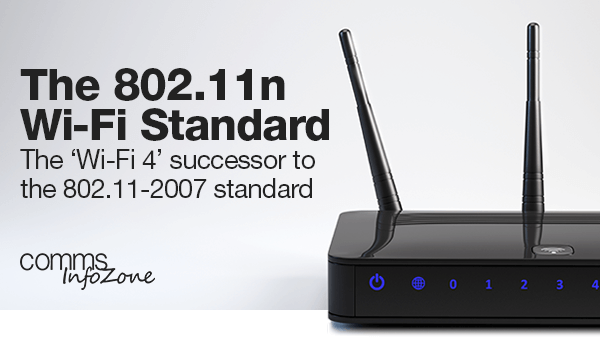
The New Standard
In 2009, the Institute of Electrical and Electronics Engineers (IEEE) created an update to the existing standard for Wireless Local Area Networking (WLAN).
They called this new standard 802:11n – or 802.11n-2009, to give it it’s full designation – to supersceede the previous standards update in 2007, 802.11-2007. Since then, to bring it more in line with the naming conventions more familiar today, they have, with the approval of the Wi-Fi Alliancce, retactively renamed the standard ‘Wi-Fi 4‘.
To Go Further Than Before
The 802.11n standard was developed to deliver improved data rates and ranges for wireless networks, offering improvements in network bandwidth. This standard was also what introduced “Multiple Input and Multiple Output” technology. Usually abbrieviated to ‘MIMO’, this technology uses multiple wireless signals and antennas at both the transmitter and receiver, leading to large improvements in communication performance. In comparison to previous 802.11 standards, this new protocol improved both range and signal intensity of wireless networks.

The 820.11n Standard
The 820.11n network can perform at a fast maximum speed and optimal signal range when compared to earlier 820.11 standards. However, an 820.11n device usually costs more than a device with 802.11g. Operational parameters also affect data rates. As many as four data streams can be transmitted at one time through 20MHz or 40MHz channels. Maximum data rates of 600 Mbit/s are possible when all four streams utilise a 40 MHz channel. The protocol also provides enhanced resistance against signal interference.
820.11n Technology for WLAN
Businesses have adopted 820.11n technology for WLAN to achieve improved throughput performance and greater reliability. The standard uses multiple antennas to generate both distance and speed improvements. 802.11n has the ability to operate in the 2.4 GHz and the 5 GHz frequency bands. This makes it backward compatible with users of the 11a and 11b/g standards. Comms Express is here to assist businesses with the key aspects of wireless network management.
*The Wi-Fi Alliance is an organisation that certifies products with 820.11 wireless technologies for interoperability. A product may be designated as ‘Wi-Fi Certified’ for marketing purposes.
In Summary (TL;DR)
802.11n, or ‘Wi-Fi 4’, is an update to the previous wifi networking standard, which introduces MIMO (Multiple Input and Oultiple Output) and increased the range and strength of wifi network signals.
Related Products Available from Comms Express:
Wireless Data Solutions | NETGEAR Wireless Access Points | TP-Link Wireless | Cisco Small Business Wireless
If you require any further information on these or any other products that we stock here at Comms Express, please do not hesitate to contact our team who will be only too happy to help.
Until next time…
